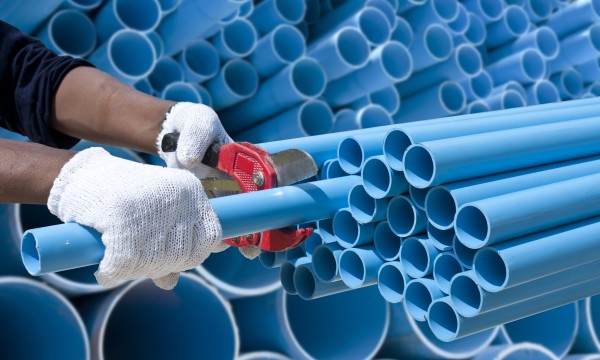From nagging leaks to new sink installations, pipes and tubes are plumbing essentials you’re going to be dealing with. Developing an understanding of the types of pipes and tubes available can help you form a big-picture approach to your DIY plumbing projects. [Photo credit: istock.com/Toa55]
- Browse Categories
- All Tips
-
Home & Garden
- All
- Appliances
- Bathroom
- Cleaning
- Crafts
- Decorating
- Electrical
- Flooring
- Furniture
- Garage Door
- Gardening
- Green Living
- Heating
- Home Alarm Systems
- Home Maintenance
- Home Remedies
- Home Security
- Home Staging
- House Sitting
- Junk Removal
- Kitchen
- Lawn Care
- Lock Systems
- Moving
- Outdoor Living
- Pest Control
- Plumbing
- Renovation
- Roofing
- Snow Removal
- Storage
- Tools
- Tree Service
- Health
- Family
- Travel
- Auto
- More Tips

Pipes and tubes: Why are there so many types?
June 7, 2017

Plumbing applications
Plumbing systems use pipes to carry water, waste and natural gas in and out of your home. Various pipes serve various purposes:
- Water supply lines carry water from a main or well to faucets and fixtures in your home.
- Drain-waste-vent (DWV) lines remove waste and gasses from your home and empty them to a sewer or septic tank.
- Gas supply lines carry gas to household appliances.
- Most DIY jobs you take on will involve water pipes, the safest and easiest to repair or install yourself.
Important!
Never attempt to install or repair a plumbing gas line on your own. It involves highly flammable, potentially deadly gasses and should only be carried out by a professional.
Pipes or tubes?
Pipes and tubes may look similar but they’re rarely interchangeable. They differ in use and measurement. DIY plumbing projects require pipe. A few facts:
- Pipes are pressure-rated and used to transport fluids and gasses. Because they move something, the inside diameter is most important. Size is determined by an inside (nominal) diameter and schedule (wall thickness).
- Tubes are used in structural applications, therefore the outer measurement and strength are important. Size is determined by the outside diameter and wall thickness.
- Tubes have stricter tolerances and are often more expensive.
Good to know!
For repair jobs, it’s handy to measure the old pipe or bring it to the store as a reference for buying the new one.
Common pipe materials
Pipes are made of either metal or plastic. Always check local code requirements to ensure the materials you select meet current standards.
Common materials used for water supply and DWV lines include:
PVC (poly-vinyl-chloride)
- The most common type of plastic, PVC pipe is rigid and comes in a variety of pressure ratings.
- Used for cold-water applications and drainage lines.
- Inexpensive and easy to install.
CPVC (Chlorinated Polyvinyl Chloride)
- Similar to PVC but more ductile and better suited to higher temperatures.
- Primarily used for residential hot- and cold-water applications.
- Often used to replace copper pipe, as it’s less expensive and much easier to install.
PEX
- Durable, flexible hose or tubing that’s cost effective and easy to install. Requires minimal maintenance.
- Great for interior residential hot- and cold-water applications and with hydronic heating.
- Resists heat better than most plastics. Resistant to bursting even if it freezes.
- Can’t be used outdoors as it degrades under UV light.
Copper
- A traditional and reliable material, but more expensive than other types. Often replaced with more affordable plastic options.
- Used with hot- and cold-water applications, usually in residential water supply lines and as a refrigerant line in HVAC.
- Available in soft form (usually for refrigerant lines) and rigid form for water pipelines.
- Can freeze and snap in extreme cold.
Cast Iron
- Strong and durable but heavy and difficult to work with.
- Used for drainage lines.
- Repairs are often made with plastic PVC piping, which joins easily to cast iron.
ABS
- Strong, corrosion-resistant and easy to install.
- Used for drainage lines.
- Less expensive than metal piping, but with a superior flow.
- Doesn’t hold up well to UV light and may be limited by outdoor plumbing code restrictions.
Good to know!
Older homes often used lead water pipes. Pipes, pipe fittings and valves containing lead in excess of 0.25 percent (with respect to wetted or contact surface) are no longer permitted for use in potable water systems.
Pipe purchase checklist
When repairing or replacing pipes, consider:
- What type of application do you need it for? Water lines, drainage?
- What material is best suited for your application? Does it meet local code guidelines?
- Do you know the correct measurements?
- Do you need pipe fittings and if so, what kind?
- Do you need any solvent cements or soldering tools?
Understanding what pipes or tubes are needed and ensuring you have the right material for the job will help your plumbing projects run smoothly. With a little more knowledge of plumbing pipes and tubes under your tool belt, you’re well on your way to taking on that leaky fixture or DIY sink installation with confidence.







